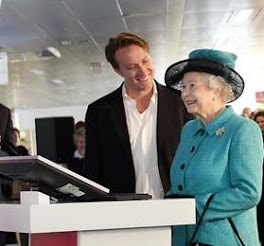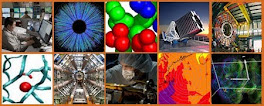Photographic negative with enhancement: Image now a "positive".
See tail-end for some October 2018 updates (yes, some 7 years after this, my initial Shroud posting!)
Even now, that faint, so-called "enigmatic" negative (tone-reversed) Shroud image is not instantly and easily explainable (especially as scientific access has been denied by the Vatican these last 40 years since that inconclusive STURP exploratory 5 -day visit in 1978) !
Why not? Because one has to be willing to think 'outside the box'. ( Seems it's no longer taught in schools and universities).
'Thinking outside the box' is - and always has been - this retired scientists's speciality. So be prepared for surprises...
Key words to look for are : SIMULATED SWEAT IMPRINT (seemingly dried and subsequently yellowed with age). You read it here first...
Start of 2011 posting:
This is a quickie post. I'll tidy it up later. It's to show some comments I have today posted to Tom Chivers blog on the Daily Telegraph with the germ of an idea (that may or may not be original).
Tom's topic title:
The Shroud of Turin: forgery or divine? A scientist writes
The comments set out briefly an idea that came to me suddenly this afternoon as to how that image on the Turin Shroud may/might have been produced in the 14th century by medieval "forgers", intent on producing yet another 'holy relic' to add to fragments of the 'real cross' etc etc. Yes, holy relics were a major growth industry in the 14th century, given they could attract thousands of pilgrims to your cathedral or whatever each year - the beginnings of the travel industry...
Comment 1:
'THERMO-STENCILLING'? (don't bother googling - you read it here first ;-)
The crucial detail is that the image is a negative, i.e. parts of the original object that were well illuminated ("light") look dark and vice versa.
A negative image might at first sight suggest some kind of photography, either early primitive, or entirely accidental, or a combination of the two.
Leaving aside the nature of the photographic emulsion and photosensitive compound there is a problem with production of any image by photography. It needs either a good convex (converging) lens to bring light rays to a focus, or failing that a pinhole camera. It seems improbable(though not impossible) that either of those technologies were available even 800 years ago at a sufficient state of development, since if there had been there would surely be a host of other artefacts available from that era (e.g. grainy photographs of royalty?).
But there is another means by which an image can be produced that does not need photography, or at any rate the focusing of light from an object. One could use 'thermo-stencilling" instead. How? By taking some white fabric, and fashioning an image using black charcoal as one would a portrait, using degrees of shading rather than a line image. One would then expose the cloth to radiant heat, say from a furnace. The black areas would absorb heat and partially scorch the cloth in immediate contact with the charcoal while the white areas would reflect light and remain unscorched. The final step would then be to wash the particles of charcoal completely out of the cloth, leaving just the brown image -
By washing out the charcoal, the observer sees no evidence of the the image having been "painted" on the cloth. All that is left is a scorch mark - and being formed under a charcoal coating, it may be subtly different perhaps from one formed by direct action of hot iron or heat rays onto fabric.
Comment 2 (omitted, largely clarification in response to a query from xxxxxxx)
Comment 3 - further clarification:
Sorry, xxxxxxx , but I don't understand your difficulty re charcoal. If you had been barbecuing, and had got charcoal dust on your shirt, would you throw your shirt away, on the assumption that it was impossible to wash out? Surely not. Even without modern detergents, charcoal, which is simply microcrystalline graphite, i.e. sheets of carbon atoms arranged as fused hexagons, giant molecules in fact, should be relatively easy to wash out.
You are not by any chance confusing charcoal with scorched or charred cloth by any chance? The procedure I propose starts by drawing on a cloth with the kind of charcoal given out in school art classes - carbonised twigs. The cloth is then "grilled", i.e. exposed to radiant heat, e.g. from red hot coals, or again, charcoal, though I hesitate to mention it, and the black, charcoal-coated areas on the cloth will heat up - and become scorched - in contrast to the white reflective areas without charcoal that will remain relatively unscorched, at least with short exposure times.
I only suggested charcoal because it is "right for the period" and probably does the job, but other black substances might serve equally well, given that black subsrtances absorb heat as well as light, provided they can be washed out after heating so as to "dispose of the evidence" so to speak as to how the negative image was produced. Please tell me if I am not making sense.
Again, I thank you for your interest, but have to say I am somewhat disappointed by the response so far. Any feasible mechanism should surely place a big question mark over the assertion of those Italian scientists that there is no known mechanism by which the image could have been produced. I maintain there is - and I have chosen to call it "thermo-stencilling".
......................................................................................................................................
Tomorrow I must get hold of some charcoal, and see whether or not the idea works as predicted. I'll use a hot ring on the cooker hob as a source of radiant heat.
Update: Saturday 31 Dec 2011 I've just this minute cut up some cotton pillowcase (OK, so it's not flax/linen as per original Turin Shroud) and then cut some batten as per piccy below to create grips - left and right - that allow the cloth to be held close to a source of radiant heat without barbecuing knuckles. Missus will add artist's charcoal to her shopping list when she goes into town this afternoon.
While waiting for the charcoal. I have been giving thought to what to use as a source of radiant heat. The initial idea was to use the cooker hob:
But there's a potential complication there - it's not just radiant heat, but hot rising convection currents as well. It's better to isolate and study one variable at a time.
The new ceiling spots in my bathroom throw off a lot of radiant heat - downwards - in the opposite direction from rising convection currents, so I will try holding my "miniature shroud" up close to a spot.
Update Sunday 1st Jan 2012
Well, missus was unable to get hold of artists' charcoal stick, but never mind, we'll try barbecue lump charcoal:
Watch this space folks (will try "grilling" under a spotlight as soon as missus has vacated the bathroom).
OK, so here's the charcoal outline being exposed to radiant heat from a ceiling spot, with the charcoal-side facing the lamp. Within a few minutes I began to see a sepia smile appearing on my side.
And here is the reverse side back on the table after just a few minutes of gentle grilling. Prediction confirmed! 'Thermo-stencilling' WORKS - and given the utter simplicity of the procedure may or might well have been the method used 800 years ago to produce the Turin Shroud.
The final step is to wash out the charcoal, leaving hopefully just the scorch mark (with no clue as to how it was formed!)
Here it is after a brief rub with soap and a rinse. Not all the charcoal is removed, but enough to see that the image is now mainly in the form of a scorch mark.
The final step is to dry over the heated towel rail:
Incidentally, if you are wondering why the whole face (and those ears) are not brown, it's because of the limited diameter of my ceiling spots. I used one (60W) in the living room - bigger than the bathroom I had originally intended to use but the diameter is still only 7cm approx.
What might have been used as a souce of heat 800 years ago? Maybe a kiln or furnace (lime? glass?) with the door open...
Have just this minute posted this to Tom Chivers blog:
"Hello again everyone (and a Happy New Year to Tom). Guess what? I have just reproduced a downmarket version of the "Turin Shroud" in miniature, using simply a cotton sheet, a lump of barbecue charcoal, a source of radiant heat and a bar of soap. It's all on my own science buzz blog:
http://colinb-sciencebuzz.blog...
newsjunkie aka sciencebod
PS: Methinks, or rather mesuspects, that none of this will come as a surprise to the canny, well-informed Vatican ... ;-)"
Update, nay, new angle, posted October 11, 2018 (nearly 7 years after this my initial Shroud posting - some 350 or more postings later!)
I drew freehand using a stick of artist's charcoal in the initial experiment described - Model 1 as I now call thermostencilling.
Yesterday I discovered one can IMPRINT with solid charcoal powder. What's more the imprints (of my fingers) bear an uncanny resemblance to the real things - essentially negative photograph-like images (ring any bells)?
Left: imprinted fingers onto DRY linen with powdered charcoal. Right: same but imprinted onto WET linen, as used with white flour imprinting medium in my Model 10.
Not bad eh? In fact I'm publishing the charcoal imprints here first, being in no hurry now to release new data to sindonology (which continues to ignore or indeed suppress my Model 10, i.e. simulated sweat imprint theory). Nuff said.
Here's a link to my current posting which explains what got me thinking about charcoal imprints (if only to better visualize what one is producing with the white flour imprints in my current Model 10, now some 3 years old and more).
https://shroudofturinwithoutallthehype.wordpress.com/2018/10/05/no-mr-barrie-m-schwortz-sturp-did-not-provide-an-example-that-future-shroud-researchers-can-use-to-carefully-plan-their-own-work-sturp-showed-how-not-to-plan-or-execute-objectiv/
Saturday October 13, 2018
Afterthought: It's suddenly occurred to me that I now have a means of comparing two entirely different mechanisms of generating a Shroud-like body-image chromophore. The first involves the linen only as source of raw material, the other involves an extraneous imprinting medium.
The first is the technique reported here on this very posting back in December 2011, i.e. "thermostencilling", which I now refer to as Model 1', but using the modification now appended, namely to imprint with finely powdered charcoal, rather than 'draw' with a charcoal stick, or, as later, apply as wet suspension. A source of dry radiant heat is used to 'scorch' the linen that is in immediate contct with the radiation-absorbing elemental carbon.
The second substitutes powdered white flour for charcoal, i.e. my Model 10, developed and reported in 2015, but again using a source of dry radiant heat for image development.
Both are expected to give a final yellow or yellow-brown imprint (after washing to remove either charcoal or loose 'toast-like' brown encrustation in the case of Model 10).
The key question is then how the two end-results compare chemically and spectrally. At the very least, they can potentially serve as reference standards for any future investigation of the TS body image, i.e. STURP Mark 2, Vatican-permitting.
Which Model do I consider closer to the TS body image? Model 10, with flour imprinting, without a doubt. I consider imprinting with flour (or some other organic, i.e. carbon/hydroge/oxygen etc -based medium in solid, powdered form being the likely means chosen by 14th century 'fakers' to simulate, a claimed (then) 13 centuries whole body sweat imprint after drying and yellowing with age. The initial near invisibpe imprint (+ more visible blood) was imagined as having been left by the newly crucified Jesus on Joseph of Arimathea's 'fine linen', en route from cross to rock tomb. The tone-reversed negative image, almost certainly produced by actual 14th century imprinting (NOT free-hand painting!) added that genius touch of authenticity, with a body image that was only just visible (and even then it was necessary to stand back a couple of metres to see it against off-white background).
I reckon the problem of the TS is now solved - just think simulated sweat imprint, seemingly yellowed with age. How much longer must one wait for authenticity-fixated sindonologists to sit up and take notice one wonders?





























